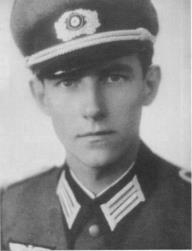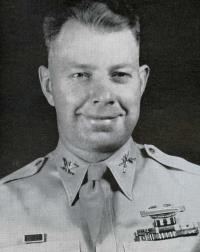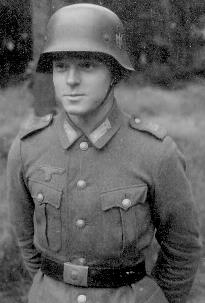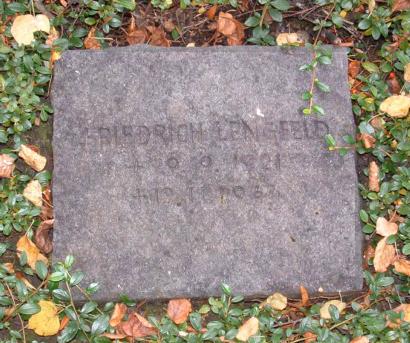![]() 1st Battalion 22nd Infantry
1st Battalion 22nd Infantry ![]()
22nd Infantry Monument to a Fallen German Soldier
|
The plaque on the monument
erected for The inscription (in both English and German) reads: No man hath greater love than he who IN MEMORY 2ND CO., FUES. BN., 275TH INF. DIV. Here in Huertgen Forest on November 12,
1944, PLACED AT THIS SITE ON OCTOBER 7, 1994 THE "Deeds Not Words" |
On October 7, 1994 members of
the 22nd Infantry Regiment Society dedicated a monument to a
German Soldier
from the Second World War. The monument stands near the entrance
to the military cemetery in Hürtgen, Germany,
the final resting place for over 2900 German Soldiers. It honors
Leutnant Friedrich Lengfeld,
a Company Commander in the German Army, who lost his life trying
to save a wounded American Soldier.
It may possibly be the only monument erected anywhere, by former
US Soldiers, to honor an act
of bravery by a German Soldier, who at the time of the act, was
an enemy at war with the United States.

Leutnant Friedrich Lengfeld
Friedrich Lengfeld (* 29.
September 1921 in Grunwald, Kreis Glatz, Schlesien; † 12.
November 1944 in Froitzheim) war ein Leutnant der Wehrmacht und
Kompaniechef der zweiten Kompanie des Füsilierbataillons der
275. Infanteriedivision
Friedrich Lengfeld ( born
September 29, 1921 in Grunwald, Kreis Glatz, Schlesien; died
November 12, 1944 in Froitzheim) was a Lieutenant
in the Armed Forces and Company Commander of the Second Company
of the Fusilier Battalion of the 275th Infantry Division
The Hürtgen Forest Monument
In the October 22, 1995 issue of "The
Arizona Republic" newspaper, Steve Wilson wrote the
following article:
One of the longest, bloodiest
and least publicized battles of World War II was fought in the
dense fir trees along the
German - Belgian border called the Hürtgen Forest.
Thirty thousand Americans were
killed or wounded in six months of fighting that began in
September 1944
and lasted far into the bitter winter. Thousands more were
disabled by combat fatigue and exposure. An estimated
12,000 Germans were killed. "Whoever survived Hürtgenwald
must have had a guardian angel on each of his shoulders, "
wrote Ernest Hemmingway, who covered the battle for Collier's
magazine.

Colonel John F. Ruggles
in his offical portrait as Commanding Officer of the 22nd
Infantry Regiment.
As a retired Major General, Ruggles was the moving force behind
the monument to LT Lengfeld.
Photo from the 22nd Infantry Regiment Yearbook 1947
One soldier who got out alive is
retired Major Gen. John F. Ruggles of Phoenix, 86. He was then a
Lieutenant Colonel
serving with the 22nd Infantry Regiment. Last year (1994) to mark
the battle's 50th anniversary, Ruggles organized an effort
among veterans of the Regiment to place a monument in the forest.
It's a very different monument. Unlike other World War II
tributes,
this one doesn't honor our own soldiers. This one honors an
unheralded act of humanity by a 23 year old German Infantry
Lieutenant.
Ruggles wasn't interested in media attention last year, and the
monuments dedication received no news coverage in this country.
But a friend recently convinced him that others would like to
hear the story, so last week he talked about it.
On November 12, 1944, Lt. Friedrich Lengfeld was commanding a
beleaguered German rifle company. Like most units on both sides,
he had suffered heavy casualties. Early that morning, a wounded
American could be heard calling from the middle of a German
minefield
in a no man's land separating the combatants. "Help me"
the man cried. His unit had withdrawn , however, and no U.S.
troops were
close enough to hear. Lengfeld ordered his men not to shoot if
Americans came to rescue the man. But none came. The soldier's
weakening voice was heard for hours. "Help me" he
called, again and again. At about 10:30 that morning, Lengfeld
could bear
the cries no longer. He formed a rescue squad, complete with Red
Cross vests and flags, and led his men toward the wounded
American.
He never made it. Approaching the soldier, he stepped on a land
mine, and the exploding metal fragments tore deeply into his
body.
Eight hours later Lengfeld is dead. The fate of the American is
unknown. Much of this story, unpublished in any American books
on the war, is based on the eyewitness account of Hubert Gees,
who served as Lengfeld's communications runner.
Speaking at the monument's dedication in Germany last October,
Gees said : " Lieutenant Lengfeld was one of the best
soldiers
of the Hürtgen Forest. He was an exemplary company commander,
who never asked us to do more than he himself was ready to give.
He possessed the complete confidence of his soldiers.
Ruggles said Lengfeld's sense of duty went far beyond the call.
" You can't go to any greater extreme than to give your life
trying to rescue someone you are fighting as your enemy in war
" he said. " Compare that to the indifference most
people feel
about each other today." The bronze and concrete monument is
believed to be the only one placed by Americans
in a German military cemetery.
To the young Lieutenant, the voice crying out that day did not
come from an enemy. Nor from an American, nor a stranger.
It came from a human being in need. Something inside Lengfeld
compelled him to act - a feeling so strong and enduring not even
the madness of war could block it. In the heavy silence of the
German forest, where thousands upon thousands met death,
that glorious impulse for life is now honored.
**********************

Soldat Hubert Gees
From the Photobucket page Wilde Sau Stellung Hubert Gees
Hubert Gees from
Salzkotten/Eastern Westphalia, Germany, was a soldier in the 2nd
Company of the Füsiliers Battalion.
On October 7 1944 his Company Commander was wounded. A
replacement Commander lasted only three days.
On about October 11, Leutnant Friedrich Lengfeld, at the young
age of 23, became Gees' third and final
Company Commander. Many years after the war Gees remembered his
Comander:
"With Lt.
Lengefeld I lost the best superior I ever had. In the previous
hard weeks he meant much to me and gave me
a lot of inner strength. He was an exemplary company leader and
he claimed never more from us as he was willing to give by
himself.
Led by him I was on patrol straight into the american forward
outposts. When the american observation ammunition detonated
on trees with a flogging bang and we got the impression that the
enemy broke into our positions he never said "Go and
check"
but "Follow me".
On November 12,
1944 when the soldiers of the 12th US Infantry Regiment had
re-taken the forester's house of Hürtgen
just to lose it again in the forenoon, our company suffered a
severe loss. In the early forenoon an obviously heavy wounded
G.I.
was crying for help in a beseeching way. He was lying in the
middle of the minefield "Wilde Sau" at the edge of the
embankment
of the eastern side of the road, in no man's land. My CO, Lt.
Lengfeld, sent me to our MG position to deliver the order
"not to shoot if american corpsmen will show up to salvage
the seriously injured". Since the heartrending cries for
help lasted for hours
Lt. Lengfeld ordered our corpsmen to put together a rescue squad.
This must have been around 10:30 am.
Lt. Lengfeld
went on top of the resque squad on our side of the road. The road
itself was secured with anti-tank mines
whose positions were relatively easy to locate. Just when the
Lieutenant wanted to change the side of the road approaching the
G.I.
he was taken down by an anti-personal mine. In a great hurry he
was taken back to our command post to be given First Aid.
Two holes in his back with the size of a coin suggested severe
internal injuries. Lt. Lengfeld moaned in great pain.
Led by a lightly wounded NCO he was brought back to casualty
station "Lukasmühle". The same evening he died
from his severe injuries on the main casualty station at
Froitzheim"
|
A photo taken in modern
times, showing the location The yellow dashed line indicates the
direction Lieutenant Lengfeld came out, The photographer was standing in front of the memorial looking south. From the website: www.faehrtensucher.com |
The following is a rough translation of some more of Hubert Gees' wartime memories of the Hurtgen:
On the afternoon of 2 November
we immediately shaped our position up to the minefield “Wild
Boar” which had already been laid
on the westerly side of road. A machine gun protected the
mine—free lane, which today leads to the cemetery. We held
this position
until the 20th of November. Our troop leadership on 3 November
threw the 116th Panzer “Windhund” Division into the
torn up
front between Schmidt and Huertgen. On 4 November the grim
counterattacks started. In the area from Vossenack to Schmidt
heavy fighting raged, accompanied by artillery duels and tank
battles. The U.S. Army Air Corps joined in the ground fighting.
Here by Huertgen counterattacks had already commenced on 3
November against the curved front of the 109th Infantry.
On 7/8 November the lO9th’s sector of the front was taken
over by the 12th Infantry Regiment of the 4th U.S. Infantry
Division.
At midday on 10 November a heavy artillery barrage lasting a half
hour opened up on the point of the forest and on the
American front line southwest of Huertgen. This was a new attempt
to throw the Americans back. After back and forth attacks
lasting for days the forest point fell, and afterwards the
forester’s house, which had changed possession several
times;
and on 13/14 November for some 10 days was again in our hands.
Whoever would like better picture of the bitter fighting, might
read the comments from the war diaries of the 116th Panzer
division
which are published in the book “The last Year of the War in
the West. Here are a few notes from the diary of 12 November
1944:
The battles swung in continual bitterness back and forth. It is
raining, wet snatches of fog or snow clouds sweep over the
softened land beset with puddles. The fighting infantrymen wading
, lying and fighting in mud are close to complete exhaustion.
The reported battle strenghts are sinking at an alarming rate.
Continually the artillery battle rolls on.” ‘In the
forest itself it looks
completely crazy. The trees are leaning on one another through
continual fire. The infantrymen Look like swine. No rest for
over a week and not dry thread on their bodies; for it is raining
continually and fog is always at hand. It is a bush war:
man against man with enormous efforts for the individual man. The
infantry of the division are completely finished. There are only
staff officers there, and very few men. But men who cannot even
be brought forward at the point of a pistol, are there.
On 12 November, after the soldiers of the U.S. 12th Infantry
Regiment had again captured the Forester’s House in a night
attack
and during the morning lost it again, our company received a
heavy blow: During the early morning an obviously severely
wounded
American soldier was crying pitifully for help. He lay in the
middle of the minefield ‘Wilde Sau” at the edge of the
embarkment
on the eastern side of the street, in No-Man’s Land. My
company commander Lt. Lengfeld sent me with the order to the
machine gun that was guarding the mine-free road that in no case
should it shoot if American medical aid men should come
to rescue the severely wounded soldier.
When the heart rending cries for help continued for hours Lt.
Lengfeld ordered our medical aid men to form a rescue troop.
It may have been about 1O:30 am; Lt. Lengfeld went to the area of
our rescue troop on our side of the street. The street itself
was secured with antitank mines, whose location was relatively
easy to recognize. As Lt. Lengfeld was on the point of crossing
the street directly over to where the severely wounded American
was lying, an exploding antipersonnel mine threw him to the
ground.
In haste he was carried back to our company OP for first aid. Two
deep holes in the back implied that there were severe internal
injuries. Lt. Lengfeld groaned under deep pain. Under the
leadership of a lightly wounded NCO he was carried immediately
to the Medical Aid Station at Lukasmuhie. But during the evening
he died of his severe wounds at the main First Aid Station
in Froitzheim. His last resting place is Grave No. 38 in
Diiren-Rälsdorf.
With this cruel turn of events, I lost my best commander. He had
meant much to me in the difficult weeks behind us and he had
given me much inner strength. He was an exemplary company
commander, who never asked us to do more than he himself was
ready
to give. He was in the lead of our reconnaissance patrol as we
moved up to the American outpost line. When American infantry
ammunition exploded in the trees overhead and gave us the
impression that the enemy had broken through, he did not order
“Go at once!”, but rather, “Come with me!”
Lt. Lengfeld was certainly one of the best soldiers of the
Huertgen Forest. He possessed the complete confidence of his
soldiers,
and had great human qualities. This was proven by his conduct
toward the seriously wounded enemy. From the company grade
officers of his stature, essentially came the fighting strength
of the troops. I was never able to determine the fate of the
severely wounded
American. He may have saved himself by reaching the American
lines before this part of the forest fell into German hands on
13/14 November.
The forward push of the U.S. 8th Infantry Division on 20./21
November paved the way for the downfall of Huertgen.
With the support of the U.S. Air Corps and the U.S. 5th Armored
Division after days of heavy fighting they succeeded in pushing
our troops out of the forest on both sides of the main road and
they succeeded in taking the village of Huertgen on 28 November
1944.
I was taken prisoner by the Americans along with three of my
comrades in the cellar of the Forester’s House near the
church.
On the evening of 28 November 1944 either fate or Divine
Providence allowed seven soldiers, all that remained of the 2nd
Company,
Fuesilie Battalion, to go amongst other prisoners into the valley
as prisoners of war. We had the good luck to survive.
Story by Hubert Gees Translation by John J.O'Malley, Jr Fredricksburg, Texas
Presentation by Ernest A. Herr
from the website: Combat Stories of World War II
**********************
Though the monument to Friedrich
Lengfeld is located at the cemetery at Hurtgen, LT Lengfeld is
not buried there.
He is buried in the small cemetery in Düren-Rölsdorf, about 10
miles away. His grave is number 38 of 69
graves in that cemetery.
His marker is unadorned, and consists of only his name, date of
birth and date of death.

Friedrich Lengfeld
* 29. 9. 1921
+ 12. 11. 1944
Photo from the website WWII In Color
**********************
|
Standing behind the
monument to LT Lengfeld Photo taken 2010 and copyright |
**********************
Home | Photos | Battles & History | Current |
Rosters & Reports | Medal of Honor | Killed
in Action |
Personnel Locator | Commanders | Station
List | Campaigns |
Honors | Insignia & Memorabilia | 4-42
Artillery | Taps |
What's New | Editorial | Links |